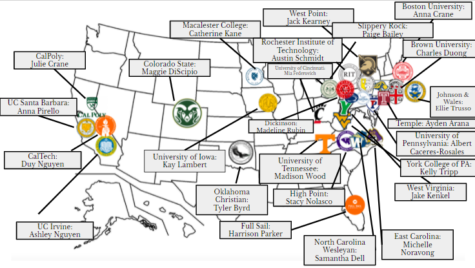Moon, Mars, and Meteors!
What is going on in space?
October 15, 2015
From finding a literal heart on Pluto to witnessing the first perigee lunar eclipse in thirty years, it has been an eventful few months in outer space. As many may have already heard, evidence of liquid water recently has been discovered on Mars. On Monday, September 28, NASA revealed a potential breakthrough for both the search for life beyond Earth and the hopes to travel to Mars in the future. NASA stated that they found evidence of super salty briny water called recurring slope lineae along the walls of Mars’ Garni Crater. No one is sure where the water comes from. There are, however, many theories including melting subsurface ice. A lander probe will be sent to Mars later this year for further research.
Science teacher Mr. Philips was incredibly excited to hear about the discovery of water on Mars. “The purpose for the Mars exposition has always been to look back on Mars’ past and see if there are conditions that would be able to harbor life. The water is really salty so there may not be life in those areas but the hope is that liquid water that is fresh may exist elsewhere and the thought of that is really exciting.”
In early July, NASA released photos of the Pluto discovery made by New Horizons. New Horizons found a heart shape on Pluto’s surface as they flew by. New Horizons’ mission is to discover our outer solar system and has spent the summer orbiting Pluto in order to do so. A little closer to home, the super blood moon lunar eclipse showed itself for the first time in thirty years on Sunday, September 29. Many amazing photos were taken from all over the world which helps a lot since it was too cloudy to really see here in Fairfax. The next perigee lunar eclipse is scheduled to make an appearance in eighteen years.
Many people stood outside their houses to see the eclipse. One of these people was Astronomy teacher Mr. Fowler. “I wish it wasn’t as cloudy but the fact that there are unique moments in time where the cosmic forces line up and you have a full moon move into the Earth’s shadow while being that close to Earth is very unique. For me, it was kind of like communicating with the universe. It was incredibly neat watching astronomical events like that unfold right before your eyes.”
Many interesting and dazzling things are happening soon in space. In October, look for the Orionid meteor shower and in November, look for the Taurid meteor shower and the Leonid meteor shower. All of these meteor showers can be seen with the human eye. So, go outside and take a look at the marvelous occurrences. Also, the last super moon of the year takes place on October 27 and the next day on October 28, Venus, Mars, and Jupiter will be able to be seen early in the morning. A little later down the line in August 2017, a solar eclipse will make an appearance.
If you would like to see a full calendar of what is going on in space for the rest of the year, visit www.seasky.org. Special thank you to Ms. Sokol for the information for this article.














